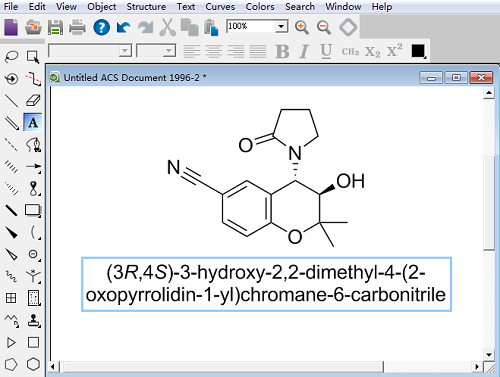
Chemical structures generated with ChemDraw are usually embedded in the proprietary file format CDX or CDXML and cannot be processed easily. This working habit for publishing chemistry results makes a reuse of chemical structures a time-consuming effort.
CHEMDRAW NAME TO STRUCTURE PDF
For the latter purpose, the documents containing embedded ChemDraw information are processed to a PDF and published together with the supporting information, which is given as PDF as well. Its use is not only preferred for the generation of reports and for documentation but also for the generation of adequate pictures for publications.
CHEMDRAW NAME TO STRUCTURE SOFTWARE
Although there are some alternatives to ChemDraw, like ISISDraw (MDL Information Systems, now a product of BIOVIA), MarvinSketch (ChemAxon) or Open Source software like Ketcher (EPAM Life Sciences), JChemPaint, and JSME which are in particular useful for an application with databases, electronic lab notebooks and diverse web-based applications, ChemDraw is still, to our knowledge, the most commonly used editor. The editor allows the application of a broad toolbox of chemical visualization tools and offers many additional functions for the generation of calculated information and identifiers. ChemDraw from CambridgeSoft (now a product of PerkinElmer) is the de facto standard chemical structure editor in the industry and is also probably the most common editor in academia. To be able to present the chemical structure in a way that allows the exchange of information, usually embedded ChemDraw drawings are used. In addition, research in chemistry suffers from one particular and fundamental requirement: chemistry research is in most of the cases connected to chemical structures which have to be presented in a user readable and understandable format. To the current situation, the re-usability of research data is far from being perfect as repositories are not used on a permanent basis, standardization projects, ontologies, and metadata are upcoming but have not yet reached the whole community, and software to analyze and process the research data is often not available to all researchers. Relevant factors are, for example, the availability and the frequent use of repositories, the standardization of scientific documentation and data formats, the use of ontologies as well as metadata, and the availability of software to analyze and process the available data. As in all other disciplines as well, the re-usability of research data in chemistry depends on manifold factors. The relevance of the reusability of research data is highlighted by many initiatives and institutions, amongst which are the FAIR (findable, accessible, interoperable, and re-usable) data initiative and the RDA (research data alliance). It has a high impact on the speed and accuracy of scientific developments and the development of common knowledge. The re-usability of scientific results is of high importance.

The project aims to support the chemists in their efforts to re-use chemistry research data by providing them missing tools for an automated assembly of reaction data. The software was designed with a focus on the processing of documents with embedded molecular structure information as CDX or CDXML as these are the most common file formats for chemical drawings. C hemS canner supports the export to Excel and CML, the direct import of the extracted data to the Open Source ELN Chemotion or the use via “copy and paste” of selected information. The extracted information is processed to reactions, molecules, as well as additional text and values and can be accessed via the C hemS canner UI. for student’s theses, PhD theses, or publications). This can facilitate the reuse of chemical information embedded into diverse documents used as standard storage and communication instrument in chemical sciences (e.g. We developed C hemS canner, a software that can be used for the extraction of chemical information from ChemDraw binary (CDX) or ChemDraw XML-based (CDXML) files and to retrieve the ChemDraw scheme from DOC, DOCX or XML documents.


 0 kommentar(er)
0 kommentar(er)
